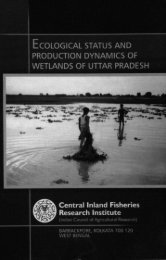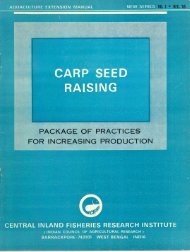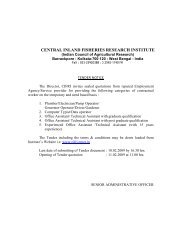Carp production using domestic sewage. - Central Inland Fisheries ...
Carp production using domestic sewage. - Central Inland Fisheries ...
Carp production using domestic sewage. - Central Inland Fisheries ...
You also want an ePaper? Increase the reach of your titles
YUMPU automatically turns print PDFs into web optimized ePapers that Google loves.
level beyond I ppm within 24 hours. Therefore, the quantity of <strong>sewage</strong> effluent to be<br />
all owed within a pond wiIl solely depend on its quality determined on the basis of BOD<br />
values. Fertilization in such a rational way always keeps the pond aerobic.<br />
5.3 Liming<br />
Application of lime in <strong>sewage</strong>-fed pond is very useful. Apart from its usefulness<br />
as promotor of fertility in <strong>sewage</strong>-fed ponds, it acts as a disinfectant against harmful<br />
parasites ca<strong>using</strong> fish diseases. Initial liming @ 200-400 kgjha is recommended<br />
before prestocking fertilization for stabilization of the pond ecosystem, Subsequent<br />
liming @ 150-200 kgjha on standing crop is necessary throughout the year during <strong>sewage</strong><br />
intake and during winter months, November-February, when high intensity of<br />
parasitic infection is common.<br />
6. STOCKING<br />
Selection of fishes for stocking depends on commercial viability and adaptation<br />
of the species to the sweage-fed ecosystem. Since the BOD levels in fish ponds fed<br />
with primary treated <strong>sewage</strong>, are mostly below 30 mgjl and dissolved oxygen concenttrations<br />
are maintained usually above 2ppm, Indian major carps are considered suitable<br />
for culture in such ponds. Considering high carrying capacity and high pro-,<br />
ductivity of <strong>sewage</strong>-fed ponds in respect to plankton and benthic fish food concentration,<br />
fishes are usually stocked at a reasonably higher density. CIFRI has conducted<br />
several trials on stocking density and species ratio with a view to increasing fish<br />
<strong>production</strong> from such ecosystem. Based on such trials, the stocking rate is recommended<br />
to be 10,000-15,000jha of carp fingerlings (10 g) and it is prof erred to stock<br />
more of omnivorous scavengers and bottom feeders to maintain fish pond hygeine for<br />
- higher yield. As such, ususal ratio followed for better output is Catla I : Rohu 2.5 :<br />
Mrigal 2.5 : Common <strong>Carp</strong> 2 : Silver carp 2. Omnivores and bottom feeders consume<br />
directly the organic detritus of <strong>sewage</strong>-fed ponds and thereby indirectly help in<br />
keeping the pond aerobic. The stocking rate of fish is kept at a higher side considering<br />
the profuse growth of algae which will otherwise grow, decay, putrify and finaIly deplete<br />
the oxygen concentration of fish pond. Stocking of phytophagus silver carp<br />
is, therefore, recommended to maintain positive oxygen balance in a <strong>sewage</strong>-fed<br />
pond.<br />
7. ECOLOGICAL CONSIDERATIONS<br />
Maintenance of aerobic condition of the <strong>sewage</strong>-fed pond is highly essential and as<br />
such early moming dissolved oxygen level should not deplete below 2 ppm for carps<br />
7













